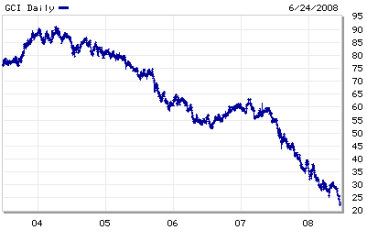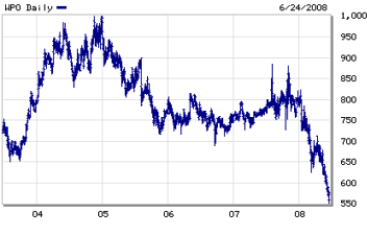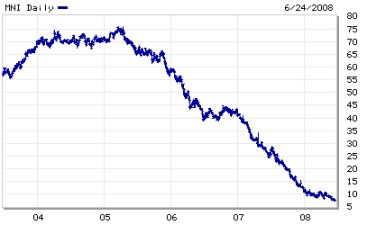
| Baseball Beat | June 25, 2008 |
Baseball Analysts (and its predecessor site) is celebrating its five-year anniversary this week. While not in on the ground floor of blogging, we have been around long enough to witness the gradual and steady shift in readership from newspapers to the Internet.
The mainstream media, slow to adopt the online medium, has been trying to play catch-up the past couple of years. Is it too little, too late? Or can the industry survive by diversifying away from its reliance on print journalism to the growing and "here to stay" Internet?
Well, if the stock prices of four of the largest publicly traded newspaper companies are leading indicators, one would have to be skeptical as to what the future holds for many of these businesses once thought to be "monopolies" in their local markets.




The chart on the upper left is none other than the New York Times Company (NYSE: NYT), which owns and operates the New York Times, the International Herald Tribune, The Boston Globe, and 16 other daily newspapers. The Company also runs more than 50 Web sites, including NYTimes.com, Boston.com and About.com.
Directly to the right of NYT is Gannett Co. Inc. (NYSE: GCI), a leading international news and information company that publishes 85 daily newspapers, including USA TODAY, the nation’s largest-selling daily newspaper.
Below NYT and GCI are the Washington Post (NYSE: WPO), a diversified media company best known for its flagship Washington Post newspaper; and The McClatchy Company (NYSE: MNI), the third-largest newspaper business in the U.S. McClatchy owns and operates 30 daily newspapers, including The Miami Herald, The Sacramento Bee, the Fort Worth Star-Telegram, The Kansas City Star, The Charlotte Observer, and The (Raleigh) News & Observer.
As you can see, NYT has gone from $45 to $16 over the past five years. GCI has fallen from a high of $90 to the low-$20s. WPO hit a peak of $1,000 and fell to a recent low of $550 before recovering to its current price of $590. MNI has fared the worse of them all, dropping from an all-time high of $75 just three years ago to the single digits.
With subscriber rates and advertising dwindling, newspaper profits are getting squeezed due to the decreasing revenues in a high fixed-cost business. It remains to be seen whether these companies can turn things around fast enough to remain viable longer term. In the meantime, look for more consolidation, layoffs, and plant closures to reduce capital expenditures and costs. Shareholders may face possible dividend cuts if cash flow weakens to the point where it no longer can support the current payouts. I wouldn't rule out bankruptcies or unwanted takeovers from opportunistic suitors, who most likely would finance the majority of such acquisitions with debt. Servicing high-cost bank debt and junk bonds would make it that much more difficult for the old media to survive without major changes to their business models.
If the truth be told, the newspaper behemoths were in the best position to lead, rather than lag, the growth in the online media space. Forward-thinking managements, while perhaps not entrepreneurial enough, could have beaten the Googles, Yahoos, eBays, and Monsters to the punch, ensuring not only their survival but prosperity for years and perhaps decades to come. Instead, newspapers are downsizing while changing their business models to focus on local events and become more like magazines by devoting space to features rather than old news.
Meanwhile, the news for the industry is chilling. Advertising revenues have dropped 12% year-over-year, the third-consecutive annual decline, as readers move online and companies follow them to what is a more measurable and targeted medium for such advertisers. Although the bulk of the downturn is secular, some of the recent problems can be attributed to cyclical issues, including a softening economy that has negatively affected subscription rates, national and local advertising, plus classified ads – heretofore the "bread and butter" of the newspaper business.
Prior to the advent of the Internet, the newspaper business was viewed positively by investors. Warren Buffett's Berkshire Hathaway has held a large stake in WPO for decades and has owned off and on stakes in several media conglomerates, including a number that have owned and operated newspapers. For the longest time, the vast majority of these businesses had little or no direct competition operating in markets large enough to support only one daily paper, while the larger papers had brand names and loyal readerships that served to reduce the potential threat of newcomers.
But times change and the New York Times and Los Angeles Times (and others) need to change with them. While most of us who have relied on the Internet as our only platform have sought to get the respect previously bestowed on print journalists, the latter have turned to blogging in an ironic twist of fates that, I guess, could be found in the department of "If you can't beat them, join them."
As it relates to the baseball world, I only hope that the Baseball Writers Association of America is paying attention. Otherwise, it may go down the same path as the newspaper business.
Comments
The good news for some of these newspapers is that they don't have much further to fall. The bottom is at zero. The "bread and butter" is a little stale as classified ads are no longer the cash cows they once were, supporting the sports section by the way. Have you tried to sell a car in the paper lately? Don't bother, you won't even get a call. Do sportswriters go to away games any more? Seems like most of the stories are "phoned in" from the local watering hole. They have free wireless internet and the MLB package at Phil Trani's for Doug Krikorian.
Posted by: Wimbo at June 25, 2008 2:51 PM
Since when is Doug Krikorian a sportswriter?
Newspapers are facing an impending doom, but don't tell Buzz Bissinger that. Most of us want it now, 24/7 and the internet is the way to go.
Congrats on the five-year mark!
Posted by: Joe at June 25, 2008 6:23 PM
Aside from baseball, newspapers shot themselves in the foot. Many people got fed up with their blatant leftist/socialist slant, cheerleading for ever-bigger government and general arrogance.
When alternate information sources came along, people dumped the daily fishwrap. Part of it was the medium, but it was mostly because of the message.
Posted by: Al Doyle at June 26, 2008 6:55 AM
if the past were the guide to the future, the most successful people in the world be be librarians living in the library....... warren buffett.
Newspapers are of the past.
1903: first flight at Kitty Hawk, USA
1969: first man on moon
66-years from first flight to first man on moon.
The internet has obsoleted newspapers. Newspapers are obsolete in the digital age.
Banks tellers obsoleted by ATM.
Cars obsoleted horse carriages.
Digital internet has obsoleted the "dead trees" of newspapers.
Posted by: charles darwin at June 27, 2008 8:26 PM
As one who just lost his newspaper job, I can say it's comforting to hear from Al that I might still be employed if only my paper had stayed in line with his political views.
However, newspapers' decline is actually more about efficiency. Newspapers were the most efficient way to distribute information for a long time, and because of that they were able to build a large, attractive audience for advertisers.
Today there's not much that a newspaper can do more efficiently than other media. My guess is that the decline from here will be quite swift.
Posted by: rfs1962 at June 29, 2008 1:01 PM